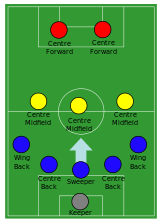Sweeper (association football)
The sweeper is a defensive position in football, so called because their job is to 'sweep up' any attacking moves which pass other defenders. It was most commonly used by football teams in Europe until the 1990s.[1] While the position usually has solely defensive duties, Franz Beckenbauer, one of the most famous sweepers, became famous for adding an offensive component of the ball playing defender. Other notable sweepers include Ivano Blason, Gaetano Scirea, Bobby Moore, Franco Baresi and Elias Figueroa. It is generally considered a highly specialized position. The sweeper is usually placed between the goalkeeper and the defensive line.[2]
The sweeper is sometimes also called 'libero' from the Italian name "battitore libero" meaning "free hitter", which describes the players' freedom from having to mark a particular opponent, as well as their liberty to play or advance with the ball out of the defence, or to make clearances instead of dribbling or playing the ball.[3][4]
Sweeper (libero)

The sweeper (or libero) is a more versatile type of centre-back who "sweeps up" the ball if an opponent manages to breach the defensive line. His position is rather more fluid than other defenders who man-mark their designated opponents. Though the sweeper may be expected to build counter-attacking moves, and as such requires better ball control and passing ability than a typical centre-back, his talents are often confined to the defensive realm. For example, the catenaccio system of play, used in Italian football in the 1950s, employed a purely defensive sweeper who only "roamed" around the back line. The more modern libero possesses the defensive qualities of the typical libero whilst being able to expose the opposition during counterattacks. Whilst rarely seen in professional football the position has been extensively used in lower leagues. Modern libero sits behind centre backs as a sweeper before charging through the team to join in the attack.[5]
Some sweepers move forward and distribute the ball up-field, while others intercept passes and get the ball off the opposition without needing to hurl themselves into tackles. In modern football, its usage has been fairly restricted, with few clubs in the biggest leagues using the position.
The position is most commonly incorrectly associated to have been pioneered by Franz Beckenbauer and Gaetano Scirea, and later by Franco Baresi and Matthias Sammer in the 1990s era, although they were not the first players to play this position, with earlier proponents such as Alexandru Apolzan, Ivano Blason, Velibor Vasović and Ján Popluhár.[6][7][8][9] Though it is rarely used in modern football, due to the prevalence of the offside trap (which precludes anyone but the goalkeeper from playing behind the back line) it remains a highly respected and demanding position.
Recent and successful use of the sweeper was made by Otto Rehhagel, Greece's manager, in the 2004 European Championship. Rehhagel utilized Traianos Dellas as Greece's sweeper to great success, as Greece surprisingly became European champions.
Although this position has become largely obsolete in modern football formations, due to the use of zonal marking, certain defenders, such as Leonardo Bonucci and Daniele De Rossi have played a similar role as a ball-playing central defender in a 3–5–2 formation:[10] in addition to their defensive skills, their technique and ball-playing ability allowed them to advance into midfield after winning back possession, and function as a secondary playmaker for their teams.[10][11]
Sweeper-keeper
Gyula Grosics from the Hungary "Golden Team" of the 1950s was thought to be the first goalkeeper to play as the sweeper-keeper.[12] More recently, Manuel Neuer has been described as a sweeper-keeper due to his speed and unique style of play which occasionally includes him acting as a sweeper for his team by rushing off his line to anticipate opposing forwards who have beaten the offside trap.[13][14] With his excellent ball control and distribution,[13][14] he has said he could play in the German third division as a centre-back if he wanted to.[15][16]
See also
References
- ↑ BBC Sports Academy
- ↑ Evolution of the Sweeper
- ↑ "DIZIONARIO DI ITALIANO DALLA A ALLA Z: Battitore" (in Italian). La Repubblica. Retrieved 21 April 2016.
- ↑ Damele, Fulvio (1998). Calcio da manuale. Demetra. p. 104.
- ↑ "Positions guide: Sweeper". London: BBC Sport. 1 September 2005. Retrieved 21 June 2008.
- ↑ Rotting fruit, dying flowers The Guardian
- ↑ Czechoslovakia World Cup Hero Jan Popluhar Dies Aged 75 Goal.com
- ↑ VELIBOR VASOVIC The Independent
- ↑ Evolution of the Sweeper
- 1 2 "Daniele De Rossi and the strange story of the Libero". forzaitalianfootball. Retrieved 5 January 2015.
- ↑ "L'ANGOLO TATTICO di Juventus-Lazio - Due gol subiti su due lanci di Bonucci: il simbolo di una notte da horror" (in Italian). Retrieved 5 January 2015.
- ↑ "The 50 Greatest Goalkeepers in History". Bleacher Report. 27 September 2013. Retrieved 28 September 2015.
- 1 2 "Manuel Neuer and the evolution of the goalkeeper". FourFourTwo. Retrieved 9 January 2015.
- 1 2 "Why Manuel Neuer should not win the Ballon d'Or". The Score. Retrieved 9 January 2015.
- ↑ "Why Manuel Neuer was the best player at the 2014 World Cup". The42. 14 July 2014. Retrieved 16 July 2014.
- ↑ Vipond, Paddy (16 July 2014). "How Manuel Neuer, Germany's 11th man, is revolutionising goalkeeping". The Guardian. Retrieved 16 July 2014.